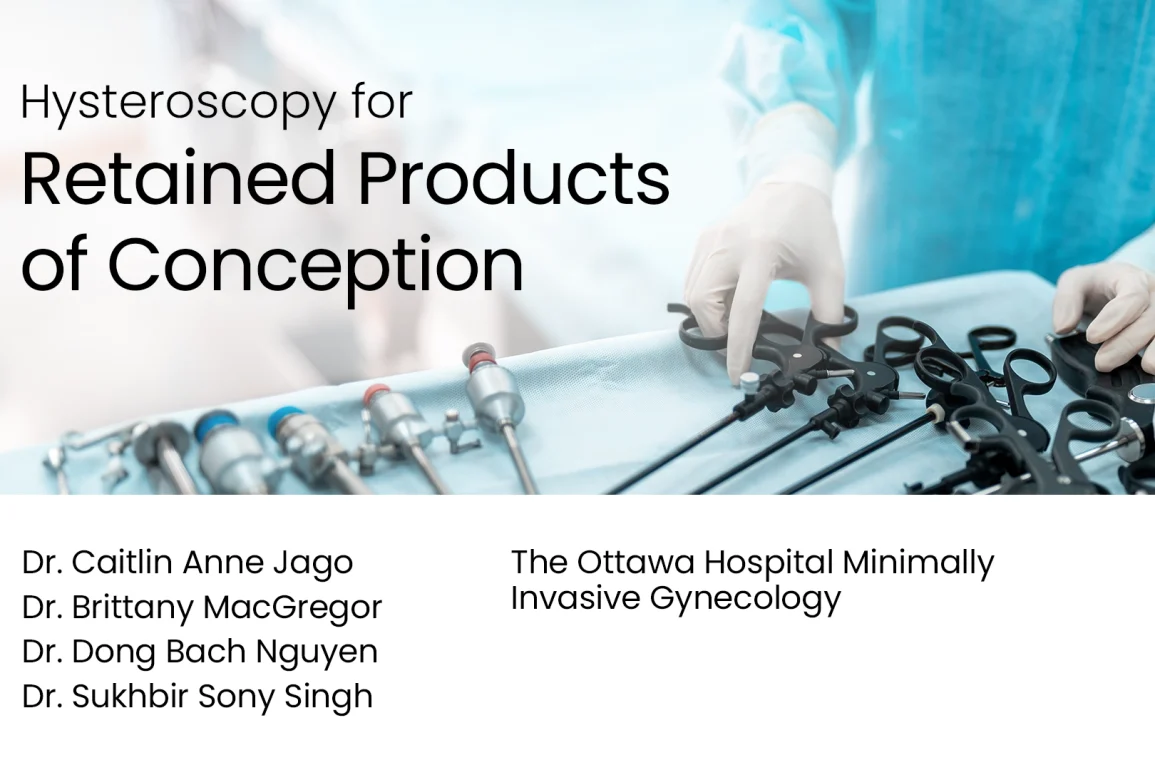Table of Contents
- Procedure Summary
- Authors
- Youtube Video
- What is Hysteroscopy for Retained Products of Conception?
- What are the Risks of Hysteroscopy for Retained Products of Conception?
- Video Transcript
Video Description
Our objectives are to describe benefits of hysteroscopy over blind D&C in management of retained products of conception (RPOC), identify the role of hysteroscopy in managing RPOC in special populations, and differentiate various hysteroscopic techniques (resectoscopes, cold loop, mechanical tissue removal systems) for management of RPOC.
Surgical footage was obtained from four patients who underwent surgery for retained products of conception at an academic, tertiary care hospital. Hysteroscopy allows direct visualization with targeted removal of RPOC to minimize trauma to the endometrium, resulting in significantly less likelihood of developing intrauterine adhesions compared to blind D&C.
Advantages of hysteroscopic management of retained products of conception include reduced risk of persistent RPOC, reduced incidence of complications, and utility in an inpatient or outpatient setting which improves patient access to care.
Presented By
Affiliations
University of Ottawa
Watch on YouTube
Click here to watch this video on YouTube.
What is Hysteroscopy for Retained Products of Conception?
Hysteroscopy for retained products of conception (RPOC) is a minimally invasive surgical procedure used to diagnose and treat the presence of residual fetal tissues or placenta in the uterus following a miscarriage, abortion, or childbirth. This condition can lead to serious complications if not treated, including heavy bleeding, infection, and infertility. During a hysteroscopy, a hysteroscope, a thin, lighted telescope-like instrument, is inserted through the vagina and cervix into the uterus, allowing the surgeon to directly view the uterine cavity on a screen. If retained products of conception are identified, specialized instruments can be used through the hysteroscope to remove the tissue, thereby avoiding the need for an open surgical procedure and minimizing the risk of uterine damage. This procedure is highly valued for its ability to precisely remove retained tissues while preserving uterine health and the patient’s future fertility.
What are the Risks of Hysteroscopy for Retained Products of Conception?
The risks of hysteroscopy for retained products of conception (RPOC) are associated with the procedure itself and the condition being treated. Although hysteroscopy is a generally safe and effective method for removing RPOC, it carries potential complications, much like any surgical intervention. Here are some of the risks associated with this procedure:
- Infection: There’s a risk of developing an infection following the procedure, which can lead to pelvic inflammatory disease if not treated promptly.
- Heavy Bleeding: Some women may experience significant bleeding during or after the procedure, which could require additional interventions.
- Uterine Perforation: Although rare, there’s a possibility that the surgical instruments could puncture the uterine wall, potentially leading to further complications.
- Damage to Surrounding Organs: There’s a minimal risk that nearby organs, such as the bladder or intestines, could be injured during the procedure.
- Intrauterine Adhesions (Asherman’s Syndrome): Scar tissue might form inside the uterus after the procedure, which can lead to menstrual irregularities, fertility issues, and problems in future pregnancies.
- Incomplete Removal: There’s a chance that not all the retained tissue will be removed, which could necessitate additional treatment.
- Anesthesia Risks: As with any procedure requiring anesthesia, there are risks associated with the administration of anesthesia, though these are generally low.
Despite these risks, hysteroscopy for RPOC is often preferred over other treatment options due to its minimally invasive nature, precision, and the lower risk of complications compared to more invasive surgeries. It’s important for patients to discuss these risks thoroughly with their healthcare provider to understand the benefits and potential downsides of the procedure based on their specific health situation.
Video Transcript: Hysteroscopy for Retained Products of Conception
The University of Ottawa presents Hysteroscopy for Retained Products of Conception. Dr Singh is a consultant for Hologic and Olympus. After this video viewers will be able to describe benefits of hysteroscopy over blind D&C, identify the role of hysteroscopy in managing RPOC in special populations, and differentiate various hysteroscopy techniques for management of RPOC.
Retained products of conception are defined as residual, placental or fetal tissue following termination, miscarriage, or delivery. Incidence is 0.5 to 1% of pregnancies.
Standard management of RPOC involves three options, expectant or conservative management, medical therapy, and surgical management, generally in the form of suction D&C. However, blind procedures are associated with complications, such as incomplete evacuation, formation of intrauterine adhesions, and uterine perforation.
To reduce complication risk, two adjuncts [?] should be considered, hysteroscopy and ultrasound guidance. Today we focus on hysteroscopy. Direct visualisation allows targeted removal of tissue and avoids trauma to the endometrium, this results in less likelihood of developing intrauterine adhesions.
Hysteroscopy can also be done in an in-patient or out-patient setting. Here, we review three scenarios where hysteroscopy is an invaluable tool for management of RPOC, including uterine anomalies, chronic RPOC and morbidly adherent placenta, we also demonstrate different hysteroscopic options.
Scenario one is a patient with previous revision of adhesions and a T-shaped uterus, presenting with miscarriage at nine weeks. Imaging showed a mass in the right cornua with vascular flow consistent with retained products of conception.
On initial look hysteroscopy, this was also visualised. Here you can see the mechanical tissue removal system being introduced against the specimen, when activated a combination of suction and a sharp blade facilitates tissue removal.
Here the cavity appears empty, but gentle, visual exploration reveals anatomic landmarks and presents of further retained products. As such, the device is once again activated to facilitate complete removal. Normal anatomic appearance is restored at the end of the case, and this is confirmed on post-op ultrasound.
In scenario two, the patient was referred four months after miscarriage with persistently elevated Beta hCG, amenorrhoea, and an enlarging right cornual mass. 3D imagining further delineates the location of the mass, and is used for surgical planning. The normal left ostium is easily identified.
Attention is turned to the right-hand side, where as you can see the right tubal ostium is included by the retained products of conception. In this case, the bipolar loop is being used. As it is activated, you can see the characteristic plasma being created around the loop itself. As with any loop or suction, the loop is brought in a cephalad direction, and then activated in a cephalad-caudad direction.
Here you can see that gentle palpation is being used in a particularly delicate area of the right cornua so as not to perforate the thin tissues. Using a combination of gentle probing and judicious use of the electrosurgery, the remaining retained tissue is resected. Ultrasound guidance was also used in this case to reduce any risk of perforation. At the end of the case, normal anatomy is restored. This was confirmed on post-op imaging.
Scenario three addresses two cases of morbidly adherent placenta. In our first case, chronionic villi are easily seen while establishing normal anatomic landmarks, such as the left tubal ostia. This patient had conservative management of suspected placenta accreta, following urgent dilation and evacuation for a loss of 22-week gestation.
She had ongoing bleeding, an ultrasound showed retained products of conception. In this case, hysteroscopic resection was planned. However, on gentle probing the tissue was less adherent to the myometrium than suspected. As such, the loop is used without energy to bluntly dissect the tissue plane. Ultrasound guidance was used in this case as another adjunct for visualisation.
The Foley catheter can be seen in the bladder, and the instrument’s visualised in the appropriate space in the endometrial cavity. Gentle, deliberate movements are performed with the cold loop. In this fashion the retained tissue is slowly dissected off the myometrium. The retained products where completely removed with resolution of symptoms following the case.
In our second case, only two small areas of retained tissue are identified. At three months post-partum this patient was having daily bleeding and ultrasound findings consistent with RPOC. Here a mechanical tissue removal device is utilised in an out-patient setting. Using this approach, complete removal of retained products was achieved with minimal patient discomfort.
Hysteroscopic management of RPOC should be considered in the following patients, those with Mullerian anomalies, chronic RPOC, and morbidly adherent placentas. A variety of different techniques can be used, including the monopolar or bipolar resectoscope, dissection with a cold loop, and mechanical tissue removal systems.
Advantages of hysteroscopy include reduced risk of persistent RPOC, reduced incidence of intrauterine adhesions, and other complications, and utility in both an inpatient and outpatient setting. Thank you to our collaborators, and thank you for your time.




